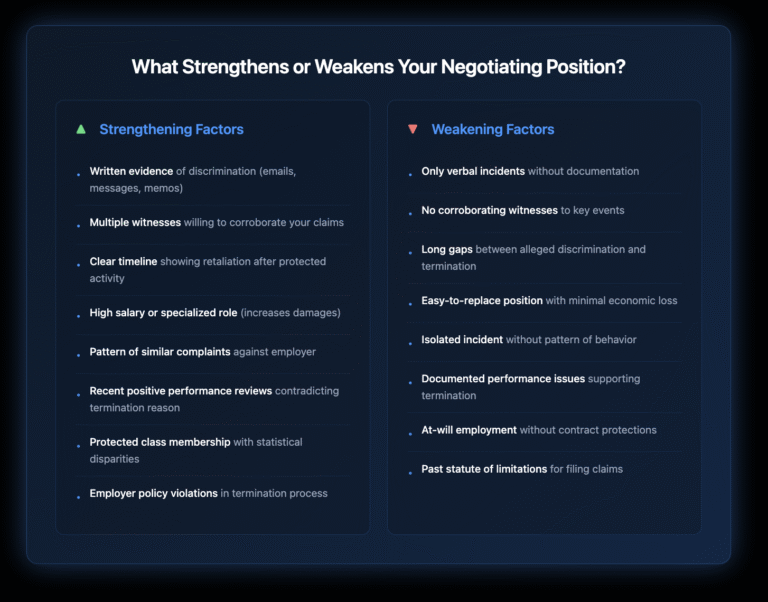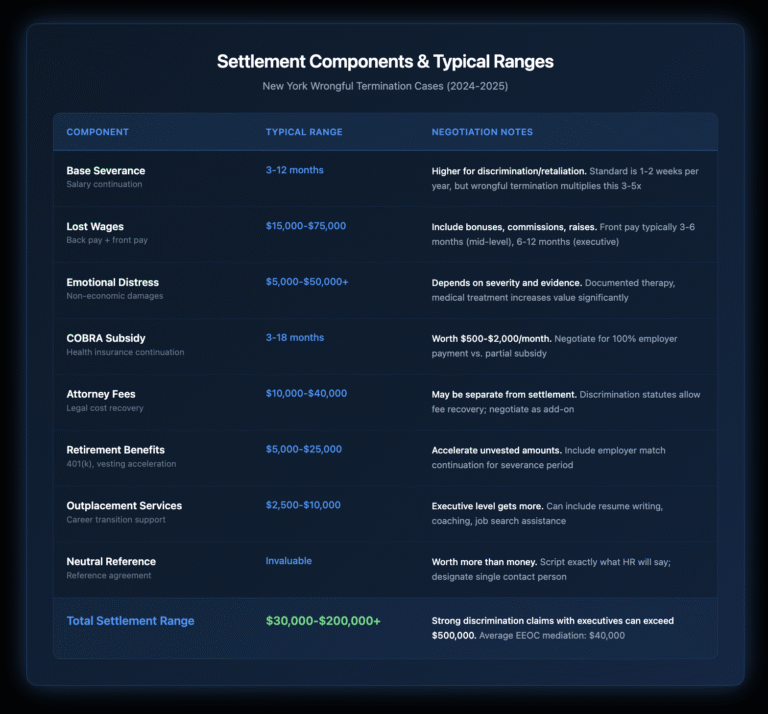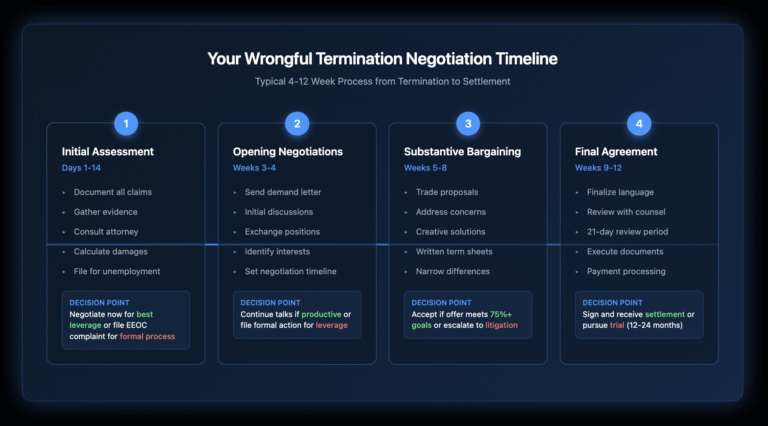After wrongful termination, you maximize your settlement by negotiating before filing formal complaints when your employer faces $75,000-$125,000 in potential litigation costs. Start by documenting discriminatory actions, calculating comprehensive damages (including 3-12 months severance, lost wages, and benefits), and then present a demand 20-30% higher than your target settlement. Most employers will negotiate rather than risk trial verdicts averaging $200,000+ for discrimination cases, giving you leverage to secure severance payments, COBRA subsidies, neutral references, and additional compensation typically totaling $30,000-$80,000 within 4-12 weeks.
Being illegally fired – whether due to discrimination, retaliation, or breach of contract – creates vulnerability for your employer that smart negotiation transforms into compensation. This comprehensive guide walks you through maximizing your wrongful termination settlement using proven strategies that work under New York employment law.
Key Takeaways
- Timing is critical: Negotiate within 2-4 weeks after termination, before filing EEOC charges, for maximum leverage
- Settlement ranges: Expect $30,000-$80,000 for strong discrimination claims; up to $200,000+ for executive-level positions
- Beyond money: Negotiate COBRA subsidies (saving $500-$2,000/month), neutral references, and benefits continuation
- Documentation wins: Written evidence of discrimination increases settlements by 40-60% on average
- Legal counsel impact: Attorney involvement typically increases initial offers by 25-50%
- Timeline: Most negotiations conclude within 4-12 weeks when handled strategically
- Tax implications: Structure settlements properly to minimize tax burden on different components
Disclaimer: This article provides general information for informational purposes only and should not be considered a substitute for legal advice. It is essential to consult with an experienced employment lawyer at our law firm to discuss the specific facts of your case and understand your legal rights and options. This information does not create an attorney-client relationship.
What Determines Your Negotiating Power After Unlawful Termination?
Your negotiating leverage comes from two sources: the strength of your legal claims and your employer’s desire to avoid litigation. Strong wrongful termination claims involve clear violations of federal or state law – termination based on protected characteristics (race, gender, age, disability) or protected activities (whistleblowing, filing complaints).
Documentary evidence significantly strengthens your position. Emails showing discriminatory comments, performance reviews contradicting the termination reason, or witness statements supporting your claim can increase settlement values by 40-60%. Higher salaries and specialized positions also increase leverage since courts calculate damages based on lost earnings.
Your employer’s motivations matter equally. Companies want to avoid litigation costs averaging $75,000-$125,000, the risk of higher jury verdicts (discrimination verdicts average $200,000+), negative publicity, and discovery that might reveal other workplace problems. Understanding these pressure points helps you negotiate effectively.

When Should You Start Settlement Negotiations?
Pre-complaint negotiations yield the best results. Negotiating before filing an EEOC charge or lawsuit often produces more generous settlements because employers can avoid the certainty of legal proceedings. You’ll typically see faster resolution (weeks versus months), lower legal costs for both parties, more flexibility in settlement terms, and easier confidentiality maintenance.
However, you need sufficient evidence before approaching negotiations. Premature negotiations without proper preparation result in lowball offers averaging just $5,000-$15,000.
After filing an EEOC charge, negotiations take on a different character. While employers may offer less once litigation begins, you gain formal discovery rights to strengthen your case, a clear demonstration of serious intent, and potential attorney fee recovery. In New York, you have 300 days to file with the EEOC and three years under the New York State Human Rights Law, giving you time to build your case strategically.
What Financial Components Should You Negotiate?
How Much Severance Can You Get for Wrongful Termination?
Base your severance request on industry standards plus the strength of your discrimination or retaliation claims. Standard severance typically equals 1-2 weeks per year of service, but wrongful termination settlements often reach 3-12 months of salary. Executive-level employees with strong claims may secure 12-24 months.
What Lost Wages Can You Recover?
Calculate back pay from termination to present, including lost bonuses, commissions, and scheduled raises. Add front pay for your expected job search duration – typically 3-6 months for mid-level positions, 6-12 months for executive roles. In tight job markets or specialized fields, courts have awarded up to two years of front pay.
How Do Benefits Factor Into Your Settlement?
Continuing benefits add significant value. COBRA subsidies alone save $500-$2,000 monthly for family coverage. Negotiate for employer-paid COBRA (typically 3-18 months), life and disability insurance continuation, and retirement contributions, including accelerated vesting and employer matches.

What Non-Financial Terms Matter Most?
How Important Is a Neutral Reference Agreement?
A neutral reference can be worth more than additional severance. Specify exactly what HR will say to prospective employers – typically confirming dates of employment, position, and that you’re eligible for rehire. Require all inquiries to go through HR with scripted responses, preventing negative comments from former supervisors.
What Should Non-Disparagement Clauses Include?
Mutual non-disparagement agreements should prevent negative statements from both parties. Define the scope carefully – these clauses should cover all company representatives, including former supervisors. Include specific penalties for violations, typically $10,000-$25,000 per incident.
How Do Confidentiality Provisions Work?
Understand what you can and cannot discuss. Most agreements allow disclosure to immediate family, attorneys, accountants, and government agencies. Overly broad confidentiality that prevents disclosure to spouses or the EEOC may be unenforceable.
Consider negotiating for file expungement – removing negative performance reviews or disciplinary actions from your personnel file. You might also negotiate changing “termination” to “resignation” to ease job searching, though this can affect unemployment benefits in New York.
What Negotiation Strategies Actually Work?
Start with information gathering. Identify who has settlement authority, understand their primary concerns, research whether they’ve settled similar claims, and calculate their potential litigation costs. This information shapes your strategy and identifies pressure points.
Frame demands using objective criteria rather than arbitrary numbers. Reference industry severance standards, jury verdict research for similar cases in New York (averaging $200,000+ for discrimination), lost wages calculations with supporting documentation, and actual benefit replacement costs.
Look for win-win solutions addressing both parties’ interests. Consider structured payments over time versus lump sums, non-monetary benefits that cost the employer less, creative solutions like consulting agreements that provide income continuity, or extended transition periods that allow knowledge transfer.
What Mistakes Should You Avoid During Negotiations?
Why Shouldn’t You Accept the First Offer?
Initial offers average just 30-40% of what employers will ultimately pay. Employers expect negotiation and start low. Counter with reasoned arguments based on your legal claims’ strength, comprehensive economic loss calculations, comparable settlements in your industry, and litigation risks for the employer.
What Beyond Money Should You Consider?
Focusing only on the settlement amount leaves value on the table. Extended benefits save thousands in COBRA costs, positive references enable future employment worth far more than severance, stock option vesting preserves earned compensation, and training funds enhance employability.
How Do Empty Threats Hurt Your Position?
Only reference actions you’re genuinely prepared to take. Empty threats to sue, go public, or report to agencies undermine credibility. Your willingness to walk away from bad deals provides ultimate leverage. If you threaten litigation, be prepared to follow through.
When Do You Need an Employment Attorney?
While some negotiations can be handled independently, legal counsel often proves invaluable for wrongful termination cases. Attorneys add value by evaluating claim strength realistically, calculating comprehensive damages including emotional distress and punitive damages potential, negotiating from a position of strength, and protecting against overreaching settlement provisions.
Attorney involvement signals serious intent. Employers often increase offers by 25-50% when attorneys appear, knowing litigation is real. Experienced employment attorneys ensure you account for all potential damages, including back pay with interest, front pay projections, benefit losses, emotional distress damages ($5,000-$50,000+), and attorney fee recovery.
What Red Flags Should You Watch for in Settlement Offers?
Watch for overly broad release language. Releases should be specific to employment claims – avoid releasing unknown claims or unrelated matters. Impossible confidentiality terms preventing disclosure to spouses or government agencies are often unenforceable and problematic.
Delayed payment terms increase default risk. Settlement payments should have clear deadlines, typically within 14-30 days of signing. Vague reference provisions need specific language and designated contact persons to be effective. One-sided non-disparagement clauses should bind both parties equally, including all employer representatives.
How Do You Finalize Your Wrongful Termination Settlement?
Once you’ve reached an agreement in principle, document everything in writing with specific deadlines and defined terms. Address tax treatment – severance and emotional distress damages have different tax implications. Specify dispute resolution procedures in case of breach.
Take time to review carefully before signing. Confirm all negotiated terms are included and verify no problematic additions. Under the Older Workers Benefit Protection Act, employees over 40 must receive 21 days to consider severance agreements and seven days to revoke after signing.
Post-settlement, calendar all deadlines, confirm payment receipt, monitor compliance with reference agreements, and maintain settlement documents indefinitely.

What Alternative Approaches Should You Consider?
Sometimes traditional negotiations stall. EEOC mediation, available at no cost, helps break deadlocks with neutral mediators suggesting creative solutions. Mediated settlements average $40,000 and are resolved within 60-90 days.
Consider converting severance to consulting fees, providing income continuity while explaining employment gaps. Structured settlements, spreading payments over time, can increase total compensation while reducing employer cash flow impact. Non-monetary resolutions like retraining, policy changes, or donations to relevant charities may provide more value than cash in some situations.
How Can Nisar Law Help Maximize Your Settlement?
Wrongful termination creates a challenging situation, but effective negotiation transforms legal violations into fair compensation and fresh starts. The key is understanding your leverage, preparing thoroughly with documentation, and negotiating strategically within optimal timeframes.
Don’t leave money and benefits on the table by accepting inadequate offers or negotiating without proper preparation. Every situation is unique – general guidance cannot replace personalized legal advice based on your specific circumstances and New York employment law.
Document everything immediately. Understand your rights under federal and state law. Calculate comprehensive damages, including all economic losses. Consider professional guidance to maximize your negotiating position.
Ready to protect your rights and maximize your wrongful termination settlement? Contact Nisar Law for a consultation about your situation. Our employment attorneys can evaluate your claims, calculate appropriate damages under New York law, and develop a negotiation strategy tailored to your circumstances and goals. Time limits apply to wrongful termination claims – don’t delay in pursuing the compensation you deserve.
Frequently Asked Questions About Wrongful Termination Settlements
Wrongful termination settlements in New York typically range from $30,000 to $80,000 for strong discrimination or retaliation claims, though amounts vary significantly based on your salary, evidence strength, and damages. The average EEOC-mediated settlement is around $40,000, while cases that go to trial average $200,000+ in verdicts (though trials are rare, occurring in less than 5% of cases). Executive-level employees with clear discrimination evidence can see settlements exceeding $200,000-$500,000. Your settlement value depends on: your annual salary (higher earners get more), the type of discrimination (disability and age claims often settle higher), documented emotional distress, whether you have written evidence, and how quickly you find new employment.
Start negotiating within 2-4 weeks after termination, before filing formal complaints, when you have maximum leverage. Send a demand letter outlining your legal claims and damages, starting 20-30% higher than your target settlement amount. Include all economic losses: back pay, front pay (3-12 months typical), lost benefits, bonuses, and emotional distress damages. Present objective evidence like emails, performance reviews contradicting the termination, and witness statements. Counter their initial offer (usually 30-40% of what they’ll ultimately pay) with specific justifications based on jury verdict research and your actual losses. Focus beyond just money – negotiate for COBRA subsidies, neutral references, extended benefits, and retirement contributions. Most negotiations conclude within 4-12 weeks through this structured approach.
Your EEOC settlement should include both monetary and non-monetary components for maximum value. Request: Financial compensation covering lost wages (back pay from termination to present), front pay (3-6 months minimum), emotional distress damages ($5,000-$50,000 depending on severity), and attorney fees if applicable. Benefits continuation, including employer-paid COBRA for 6-18 months (worth $500-$2,000 monthly), retirement account contributions, and accelerated stock vesting. Employment protections such as a neutral reference agreement with specific language, expungement of negative personnel records, changing termination to resignation on records, and mutual non-disparagement clauses. Practical terms like eligibility for rehire status, non-disclosure of the settlement terms to future employers, and a structured payment schedule with clear deadlines. Remember that EEOC settlements aren’t taxable for physical injury or sickness portions, so structure accordingly.
Employment lawyers typically charge 33-40% on contingency for wrongful termination cases, though New York courts can review fees for reasonableness. The percentage often depends on when the case settles: 33% if settled before filing suit, 35-40% if settled after filing, and 40% if the case goes to trial. Some attorneys use sliding scales based on recovery amount. However, discrimination statutes like Title VII allow for separate attorney fee recovery from your employer, meaning you might keep your entire settlement while the employer pays your attorney separately. Always clarify fee structures upfront and get the agreement in writing. Consider negotiating the percentage for larger settlements – some attorneys will reduce their percentage for settlements over $100,000.
Watch for these problematic provisions that could hurt you long-term: Overly broad releases that waive unknown claims or non-employment matters (you should only release employment-related claims you’re aware of). Impossible confidentiality terms preventing disclosure to spouses, attorneys, or government agencies like the EEOC. One-sided non-disparagement that restricts only you while allowing the employer to make negative comments. Delayed or conditional payments beyond 30 days or contingent on undefined “cooperation.” Non-compete clauses that weren’t in your original employment agreement. Admission of wrongdoing or statements that you weren’t discriminated against. Forfeiture clauses require repayment if you file for unemployment or apply to competitors. Vague reference language without specifying who responds and what they’ll say. If you see these terms, don’t sign without negotiating changes or consulting an attorney.
Negotiating severance rarely backfires if done strategically, but poor timing or tactics can reduce your leverage. The main risk is waiting too long – your leverage decreases significantly after signing any initial paperwork or passing the 300-day EEOC filing deadline. Aggressive demands without supporting evidence might cause employers to withdraw offers, though this is uncommon since employers want to avoid litigation. To prevent problems: document everything before negotiating, make reasonable demands based on comparable situations, maintain professional communication even when upset, and avoid threats you won’t follow through on. Most employers expect negotiation and build a cushion into initial offers. If you have legitimate legal claims (discrimination, retaliation, breach of contract), negotiating actually reduces risk for both parties by avoiding costly litigation.
Win settlement negotiations by maximizing leverage before formal proceedings begin. Start with thorough preparation: document all potential legal claims with evidence, calculate comprehensive damages including emotional distress, and research comparable settlements in your industry. Time your approach strategically – negotiate within 2-4 weeks post-termination when employers are most motivated to avoid litigation. Present your position professionally using objective standards like jury verdict research (discrimination cases average $200,000+) and actual litigation costs ($75,000-$125,000 for employers). Create value through creative solutions: propose consulting agreements instead of straight severance, suggest structured payments that help employer cash flow, or trade monetary compensation for enhanced benefits or references. Know your walk-away point based on realistic litigation outcomes and be genuinely prepared to file with the EEOC if needed. Success means achieving 75% or more of your goals, not necessarily the highest dollar amount – sometimes a neutral reference and quick resolution provides more value than prolonged fighting for extra money.


